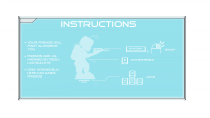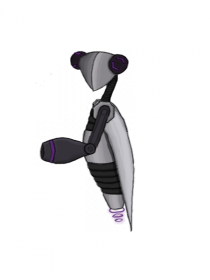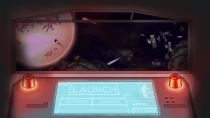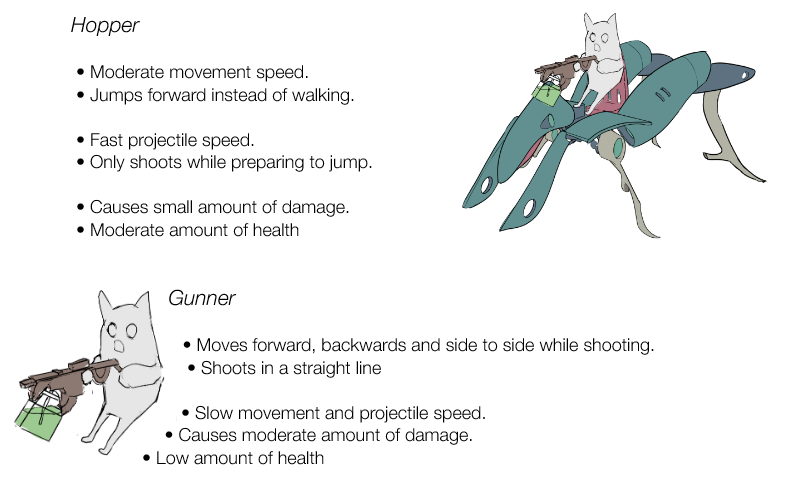Author Archives: William Teurnell
Final comment, Group Vampire
Hello,
I was mighty impressed by the narrative solution you employed. I have a soft spot for story-driven elements and your running slides hit that spot perfectly.
You are structured and organised in your approach in the text, and it is easy to get a clear overview of your successes and failures. You make your points relevant by not only mentioning which aspects were relative successes, but because you go into detail as to why you think that is.
You mention early in […]
Final comment, Group Vampire
Hello,
I was mighty impressed by the narrative solution you employed. I have a soft spot for story-driven elements and your running slides hit that spot perfectly.
You are structured and organised in your approach in the text, and it is easy to get a clear overview of your successes and failures. You make your points relevant by not only mentioning which aspects were relative successes, but because you go into detail as to why you think that is.
You mention early in […]

Post Mortem
Overall, Friendship Down turned out surprisingly as planned; the final product shipped with all intended features implemented. The final game is a 2.5D side scrolling shooter where the player is able to move, fire projectiles, and to activate a shield to block enemy shots. Additionally, the powerups of the game come in the form of allied NPCs (referred to as ”Friends”) that aid the player in defeating the incoming waves of enemies. The difficulty of the game was designed in […]

Post Mortem
Overall, Friendship Down turned out surprisingly as planned; the final product shipped with all intended features implemented. The final game is a 2.5D side scrolling shooter where the player is able to move, fire projectiles, and to activate a shield to block enemy shots. Additionally, the powerups of the game come in the form of allied NPCs (referred to as ”Friends”) that aid the player in defeating the incoming waves of enemies. The difficulty of the game was designed in […]
Comment week 5
Hello,
I enjoy your fresh take on Umibozu. I’ve got a few pointers regarding the text. You early on specify which game you’re making (you give the reader a quick memory-refresh, summarising the game very concretely and precisely), which is a very appropriate way to start a text. You are clear and specific about what forms of data you were collecting, and mention your results. It would benefit the overall appeal of the post if you included some graphical display of […]
Comment week 5
Hello,
I enjoy your fresh take on Umibozu. I’ve got a few pointers regarding the text. You early on specify which game you’re making (you give the reader a quick memory-refresh, summarising the game very concretely and precisely), which is a very appropriate way to start a text. You are clear and specific about what forms of data you were collecting, and mention your results. It would benefit the overall appeal of the post if you included some graphical display of […]
Comment Week 4
Greetings Hanna,
(William Teurnell, Team Poltergeist)
I enjoy the effects you are reaching for. You go into good detail on your thoughts and processes, and your decisions are clearly motivated. You explain the impact and intended meaning of your visuals, and you let the reader know of its significance. It was interesting how you recognised and worked around the fact that there was no animation by creating a sprite that appears caught-in-motion. I liked the end result for this reason; it looks […]
Comment Week 4
Greetings Hanna,
(William Teurnell, Team Poltergeist)
I enjoy the effects you are reaching for. You go into good detail on your thoughts and processes, and your decisions are clearly motivated. You explain the impact and intended meaning of your visuals, and you let the reader know of its significance. It was interesting how you recognised and worked around the fact that there was no animation by creating a sprite that appears caught-in-motion. I liked the end result for this reason; it looks […]
Comment week 3
Hello,
(William Teurnell, Team Poltergeist)
I enjoyed your post. It is systematic and comprehensible in an easy-to-follow way. You lead the reader into the text well by having a form of short introduction; your main point is summed up early. The same goes for the ending, where you sum up the points that you’ve made. I do, however, notice certain lacks of clarity at places. The fourth paragraph, regarding Trello, is somewhat unclear to me. I did not understand at first that […]
Comment week 3
Hello,
(William Teurnell, Team Poltergeist)
I enjoyed your post. It is systematic and comprehensible in an easy-to-follow way. You lead the reader into the text well by having a form of short introduction; your main point is summed up early. The same goes for the ending, where you sum up the points that you’ve made. I do, however, notice certain lacks of clarity at places. The fourth paragraph, regarding Trello, is somewhat unclear to me. I did not understand at first that […]
Comment week 2
(William Teurnell, Group Poltergeist)
You describe in good detail how you went about learning a new field. You briefly touch upon problems you have encountered, though you are quite vague in their description; you mention that most problems were small-scale, and then give an example of a technical issue you had (adding samples to LMMS). You don’t, however, mention any other problems, even though you imply that you had more. Perhaps you could go into greater detail into what different kinds […]
Comment week 2
(William Teurnell, Group Poltergeist)
You describe in good detail how you went about learning a new field. You briefly touch upon problems you have encountered, though you are quite vague in their description; you mention that most problems were small-scale, and then give an example of a technical issue you had (adding samples to LMMS). You don’t, however, mention any other problems, even though you imply that you had more. Perhaps you could go into greater detail into what different kinds […]
Making one’s great ideas actually noticeable
As the name suggests, the core aesthetic of Friendship Down is friendship and comradery. In pursuit of this goal, the game was designed around a specific core mechanic: the player is given an activated ability that produces a shield with which the player can ward off enemy projectiles, potentially protecting both themselves and the Friends (allied NPCs that fight alongside the player. Within the context of the game these are referred to as the Friends). From this core design choice, […]
Making one’s great ideas actually noticeable
As the name suggests, the core aesthetic of Friendship Down is friendship and comradery. In pursuit of this goal, the game was designed around a specific core mechanic: the player is given an activated ability that produces a shield with which the player can ward off enemy projectiles, potentially protecting both themselves and the Friends (allied NPCs that fight alongside the player. Within the context of the game these are referred to as the Friends). From this core design choice, […]

Communicating function through visual means
Our group’s version of Friendship Down features an antagonist, robotic species that make up the game’s enemy units. For reasons of time, we had to cut any boss fights from development. Because of this, we had to make as much use of the enemy units as possible in order to provide some form of gameplay variety, as well as an escalating sense of progression over the course of the game. There are three enemy units, each with their own specific […]

Communicating function through visual means
Our group’s version of Friendship Down features an antagonist, robotic species that make up the game’s enemy units. For reasons of time, we had to cut any boss fights from development. Because of this, we had to make as much use of the enemy units as possible in order to provide some form of gameplay variety, as well as an escalating sense of progression over the course of the game. There are three enemy units, each with their own specific […]

Visual design choices in conjunction with SCRUM
Friendship Down is the first form of concrete game development that our group, a squad of first year students, undertake. Lack of prior experience – potentially both within the field of our respective minors and in the processes of development as a whole – was initially present in all of us. It was important to consider this context as we moved into the production of the game. SCRUM encourages an early assessment of risks and potential causes of project failure, […]

Visual design choices in conjunction with SCRUM
Friendship Down is the first form of concrete game development that our group, a squad of first year students, undertake. Lack of prior experience – potentially both within the field of our respective minors and in the processes of development as a whole – was initially present in all of us. It was important to consider this context as we moved into the production of the game. SCRUM encourages an early assessment of risks and potential causes of project failure, […]

The main menu as a narrative tool
Friendship Down’s original concept document provides basic narrative direction: while on a peaceful mission, the crew of the spacefaring vessel The Friendship is abruptly attacked by a hostile alien race. The crew (a squad of friends) is forced to abandon their ship using escape pods, and then land on an unfamiliar world where they must fend off their attackers and find a means of escaping the planet. This basic storyline was intended to be communicated through an introductory cutscene, showing […]

The main menu as a narrative tool
Friendship Down’s original concept document provides basic narrative direction: while on a peaceful mission, the crew of the spacefaring vessel The Friendship is abruptly attacked by a hostile alien race. The crew (a squad of friends) is forced to abandon their ship using escape pods, and then land on an unfamiliar world where they must fend off their attackers and find a means of escaping the planet. This basic storyline was intended to be communicated through an introductory cutscene, showing […]

Reasonings behind the character design of the basic enemy
In the original Friendship Down concept document, the envisioned enemy was an ‘alien race with intent to kill’ and is in the document shown as a mix of seemingly organic creatures and mechanical constructs (see image).
These were intended as different enemy types, featuring different movements and mechanics. However, when planning the project to fit the scope of the given assignment, and in particular to compensate for the group having only a single programmer, it was decided in pre-production that alterations […]

Reasonings behind the character design of the basic enemy
In the original Friendship Down concept document, the envisioned enemy was an ‘alien race with intent to kill’ and is in the document shown as a mix of seemingly organic creatures and mechanical constructs (see image).
These were intended as different enemy types, featuring different movements and mechanics. However, when planning the project to fit the scope of the given assignment, and in particular to compensate for the group having only a single programmer, it was decided in pre-production that alterations […]

Reasonings behind the character design of the basic enemy
In the original Friendship Down concept document, the envisioned enemy was an ‘alien race with intent to kill’ and is in the document shown as a mix of seemingly organic creatures and mechanical constructs (see image).
These were intended as different enemy types, featuring different movements and mechanics. However, when planning the project to fit the scope of the given assignment, and in particular to compensate for the group having only a single programmer, it was decided in pre-production that alterations […]

Reasonings behind the character design of the basic enemy
In the original Friendship Down concept document, the envisioned enemy was an ‘alien race with intent to kill’ and is in the document shown as a mix of seemingly organic creatures and mechanical constructs (see image).
These were intended as different enemy types, featuring different movements and mechanics. However, when planning the project to fit the scope of the given assignment, and in particular to compensate for the group having only a single programmer, it was decided in pre-production that alterations […]